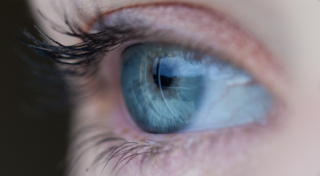"With Retinal Disease, Persistence Can Pay Off" by Yasser Elshatory, M.D., Ph.D., F.A.C.S.
A patient who was initially doing well after a recent cataract surgery, experienced a sudden worsening of vision. Their eye became red, and they developed severe pain. The vision had worsened from 20/30 (two lines from 20/20) to counting fingers (only able to count fingers of the examiner presented one foot away from their face). I examined the patient, who had severe inflammation in the eye, and I performed an ultrasound of the eye, which showed dense inflammation in the vitreous cavity.
Fig. 1. Ultrasound image of the eye showing grainy white dense material consistent with infectious/inflammatory debris.
Normally, the vitreous cavity is clear, allowing light to pass through largely unimpeded to the retina. In this case, the vitreous inflammation was due to a severe infection following cataract surgery known as endophthalmitis. I discussed the diagnosis with the patient, and recommended treatment in the office, where I would first anesthetize the eye, then remove a sample of fluid from the vitreous cavity to send to a lab for bacterial cultures. Then, I would inject two broad spectrum antibiotics in the eye that would treat a wide range of potential bacteria. This was uneventful, and the patient did well with the procedure. The infection was controlled with this single treatment. One month later, however, the patient developed a retinal detachment. Cataract surgery, infection/inflammation, and removing vitreous for the culture can all cause the vitreous to move, potentially pulling on abnormal attachments between the vitreous gel and the retina. A tear in the retina can lead to a detachment. We scheduled surgery during which I placed a silicone band around the eye, flattened the retina, and performed laser to tack the retina down. I also placed silicone oil in the eye to help hold the retina in place, and explained the need to remove the oil after several months, after we confirmed that the retina was well positioned for a prolonged period.
Fig 2. Cross-sectional view of the macula showing silicone oil reflection on the retinal surface (white bright line), and a flattened retina without a detachment.
The vision is typically blurry with silicone oil in the eye, but still better than it would have been had the detachment worsened. Several months later during follow-up, while the retina looked in good position, the patient started to develop a macular pucker, a thin translucent membrane on the surface of the macula that can blur and distort vision.
Fig 3. Cross-sectional view of the macula showing a membrane on the retinal surface and cystic changes near the fovea related to the membrane.
Since we had planned on removing the oil around this time with an additional surgery, we discussed how this would be an appropriate time to remove the membrane at the same time the oil was being removed. The patient tolerated the surgery well, the oil and membrane were removed, and they recovered 20/25 vision in this eye that had a severe infection, then a retinal detachment, then a macular pucker.
Fig. 4. Cross sectional view of the macula after oil removal and after removing the macular pucker/membrane on the surface of the retina.
Some bacterial infections are more virulent. Even with the same persistence and expedient care, the same outcome cannot be replicated. Certain bacteria, for example, can spew bacterial toxins that destroy the retina, and other infections, such as those caused by viruses, can obliterate the blood flow to the retina, causing irreversible damage to it. As much as doctors try to provide a prognosis, sometimes both the provider and patient can be pleasantly surprised by the benefits of persistence.

Comments
Post a Comment